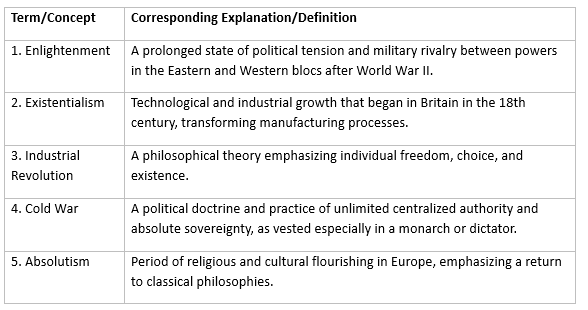Worksheet: Changing Cultural Traditions | History Class 11 - Humanities/Arts PDF Download
| Table of contents |

|
| Fill in the Blanks |

|
| Match the Column |

|
| Assertion and Reason Based |

|
| Very Short Answer Type Questions |

|
| Short Answer Type Questions |

|
| Long Answer Type Questions |

|
Fill in the Blanks
Q1: The term 'Renaissance' literally means _______.
Q2: Who is known as the 'Father of Humanism'?
Q3: The Renaissance began in Italy and later spread to _______.
Q4: The term 'Renaissance Man' is used to describe individuals with many interests and skills, often combining the roles of _______.
Q5: The fall of Constantinople to the Ottoman Turks in 1453 had a significant impact on _______.
Q6: The invention of the printing press is credited to _______.
Q7: The Reformation movement in the sixteenth century led to the churches in _______ breaking their connection with the Pope and the Catholic Church.
Q8: Martin Luther's campaign against the Catholic Church in 1517 is known for his publication of _______.
Match the Column

Assertion and Reason Based
Q1: Assertion: Renaissance marked a revival of ancient Greek and Latin culture.
Reason: Renaissance began in Italy and later spread to Rome, Venice, and Florence.
(a) Both Assertion and Reason are true, and Reason is the correct explanation of Assertion.
(b) Both Assertion and Reason are true, but Reason is not the correct explanation of Assertion.
(c) Assertion is true, but Reason is false.
(d) Both Assertion and Reason are false.
Q2: Assertion: The fall of Constantinople to the Ottoman Turks had a significant impact on Renaissance.
Reason: Trade with the East became difficult after Constantinople's fall, leading to changes in the economic life.
(a) Both Assertion and Reason are true, and Reason is the correct explanation of Assertion.
(b) Both Assertion and Reason are true, but Reason is not the correct explanation of Assertion.
(c) Assertion is true, but Reason is false.
(d) Both Assertion and Reason are false.
Very Short Answer Type Questions
Q1: What is the meaning of the term 'Renaissance'?
Q2: Who is known as the 'Father of Humanism'?
Q3: Which Italian cities were at the center of the Renaissance movement?
Q4: How did the fall of Constantinople impact trade?
Q5: Who is credited with the invention of the printing press?
Q6: What was the Protestant Reformation, and who initiated it?
Q7: How did Martin Luther challenge the authority of the Catholic Church?
Q8: What was the Counter Reformation Movement?
Short Answer Type Questions
Q1: Describe the role of Italian universities in the Renaissance movement.
Q2: Explain the impact of the printing press on the spread of education.
Q3: Discuss the causes and consequences of the Reformation movement.
Q4: How did Renaissance change the perception of individuality and citizenship?
Q5: What were the key developments in Europe during the Renaissance and Reformation periods?
Long Answer Type Questions
Q1: Renaissance played a pivotal role in shaping the cultural traditions of Europe. Discuss the causes and effects of the Renaissance movement, emphasizing its significance in the transition to the Modern Age. (150-200 words)
Q2: The Reformation movement in the sixteenth century challenged the authority of the Catholic Church and led to significant religious and societal changes. Explain the causes, key figures, and consequences of the Reformation movement, including the Counter Reformation. (150-200 words)
You can access the solutions to this worksheet here.
|
27 videos|125 docs|20 tests
|
FAQs on Worksheet: Changing Cultural Traditions - History Class 11 - Humanities/Arts
| 1. What are some examples of changing cultural traditions in the field of arts? |  |
| 2. How do changing cultural traditions impact the field of humanities? |  |
| 3. What are the challenges faced by artists in adapting to changing cultural traditions? |  |
| 4. How does technology contribute to changing cultural traditions in the arts? |  |
| 5. In what ways can individuals and societies embrace changing cultural traditions in the arts? |  |















